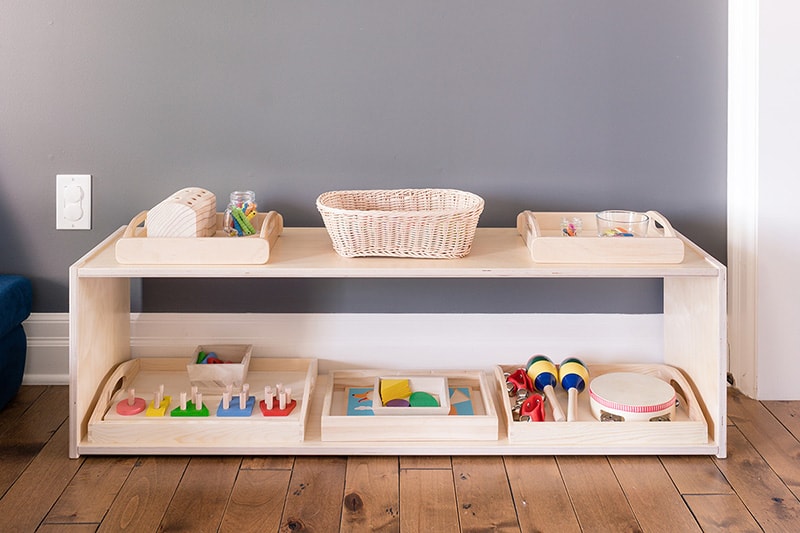If you have young kids but still want to keep your home clean and aesthetically pleasing consider a Montessori style playroom.
Not only is a Montessori playroom beautiful, but it helps to keep children engaged with their activities and gives them a sense of order (which toddlers need).
If you aren’t familiar with Montessori, in short, the Montessori Method provides children with a prepared environment where each element exists for a reason in order to help the development of the child.

Important Design Factors For The Playroom
A Montessori playroom generally follows these rules: is simple with a limited number of toys/activities has everything displayed nicely at the child’s level include some open space uses toys that promote engagement over entertainment
has a set place for items to create order/routine mixes in a variety of activities is a cozy space that your child will enjoy
How is this different from a traditional playroom you might find in a home?
Oftentimes playrooms are full of every toy the family owns (sometimes leaving little space for movement and play), toys don’t have a specific place to be stored (making it tough for kids to know where to put things back), and things can get messy and unorganized.
Let’s take a look at how you can design your playroom in a beautiful Montessori way.
Keep Things Simple
As mentioned above, many parents will store all of the toys the family owns in the playroom. Not only does this often lead to a mess, but more activities will actually negatively affect the child’s concentration.
A Montessori playroom limits the toys and activities so that the child can engage with and master a small number of activities at a time. This leads to more concentration and more meaningful play. Not to mention, your playroom will be easier to keep tidy!
Toys that are not out on display can be kept in storage and rotated every week or when the child loses interest in the other toys that are in the playroom.
Design For Your Child First
When designing rooms in our homes we are often looking from a grown-up’s point of view. But in Montessori, it’s recommended that everything is at the child’s height and accessible to them at their current size.
This means that the toys and activities are at a height that they can reach and put back on their own with ease, but also any artwork or decor in the playroom should be at their height to enjoy.
The playroom shelf should be low to the ground and an open-style shelf so that the child can see the toys on display encouraging more engagement with them.

Choosing Your Toys
Here’s my favorite part about a Montessori playroom. Many of the toys made for Montessori homes are aesthetically pleasing and beautifully designed wooden toys.
Most toys that are made today light up and make noise keeping kids entertained and distracted, but don’t serve much of a purpose for the child. On the other hand, Montessori style toys are often made from natural materials such as wood because they are simple, environmentally friendly, and last for years.
This means that not only will your Montessori toys serve a better purpose for your kid, but will also make for a beautiful playroom too.
Make sure to mix in a variety of activities including puzzles, practical life, language activities, books, musical instruments, and activities designed to work on skills such as fine motor skills and problem-solving.
Don’t Forget Open Space
Less is more in a Montessori playroom, and you will want to ensure there is lots of open space. This might be tougher for a small playroom, but the great thing about Montessori playrooms is you don’t need to have a lot of toys taking up room.
Open space is important to allow the child to have room for their work, but also for gross motor development. Studies have shown that gross motor skill is important for cognitive development in children.
If possible, it’s beneficial to add in some type of gross motor activity in the open space. The Pikler triangle is a popular playroom item in the Montessori community, but anything that would help a toddler with their gross motor skills is great.
Make It Cozy And Inviting
When designing your playroom try to create a cozy and inviting environment for your little one. You want this to be a space that they can enjoy (and let’s face it, as parents there are times that we hope that they will go play independently while we get some stuff done around the house).
This will look different for each family but could include a comfortable rug or carpet in the playroom, natural light, a comfy place to sit (small couch, chair or floor pillows), family pictures, plants or flowers, and/or nice artwork. Whatever works for you and your little one(s)!

Make Your Montessori Playroom Work For You!
I hope you enjoyed this article and it gave you some inspiration for setting up your Montessori style playroom at home.
And remember, all of the above are just guidelines for designing a Montessori playroom, but ultimately it’s whatever works for your family and your space.
